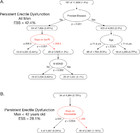Exploring Efficient Treatments For Eating Disorders: A Comprehensive Case Examine
Introduction
Consuming disorders (EDs) encompass a spread of psychological situations characterized by abnormal or disturbed eating habits. Widespread varieties embrace anorexia nervosa, bulimia nervosa, and binge-eating disorder. These circumstances can have extreme bodily, emotional, and social penalties. This case study examines effective treatment modalities for EDs, specializing in a composite affected person case that illustrates the multifaceted method required for successful restoration.
Patient Background
The affected person, referred to as « Sarah, » is a 24-12 months-outdated female who presented with symptoms of anorexia nervosa. She had a big historical past of restrictive consuming, extreme train, and physique picture distortion. Sarah’s household reported that her consuming behaviors started in her late teenagers, coinciding with increased academic pressures and social comparisons. By the point she sought treatment, Sarah had lost roughly 30% of her body weight and was experiencing extreme anxiety, depression, and social withdrawal.
Assessment and Prognosis
Upon initial evaluation, Sarah underwent a complete evaluation, including psychological testing, medical history evaluate, and physical examination. If you loved this article and you simply would like to be given more info pertaining to erectiledysfunctiontreatments.online generously visit the webpage. The outcomes confirmed a analysis of anorexia nervosa, characterized by:
- Restrictive Consuming Patterns: Sarah consumed lower than 800 calories per day and engaged in excessive bodily activity.
- Body Picture Distortion: Despite being underweight, she perceived herself as overweight.
- Comorbid Circumstances: Sarah also exhibited symptoms of generalized anxiety disorder and average depression.
Treatment Plan
The treatment plan for Sarah was multifaceted, involving a mixture of medical, psychological, and nutritional interventions. The first purpose was to revive her physical well being and deal with the underlying psychological points contributing to her consuming disorder.

1. Medical Intervention
Medical stabilization was the first priority. Sarah was referred to a physician specializing in eating disorders who monitored her vital indicators, electrolyte levels, and total health. Because of her low weight, she was placed on a structured refeeding program that regularly increased her caloric intake to stop refeeding syndrome, a doubtlessly life-threatening situation that can happen when reintroducing food after a period of malnutrition.
2. Nutritional Counseling
Sarah labored with a registered dietitian to develop a meal plan aimed at restoring her weight and normalizing her consuming patterns. The dietitian centered on:
- Training: Teaching Sarah about balanced nutrition and the importance of varied food groups.
- Meal Planning: Making a structured meal plan that included common meals and snacks to fight her restrictive tendencies.
- Aware Eating: Encouraging Sarah to practice mindfulness throughout meals to boost her relationship with food.
3. Psychotherapy
Psychotherapy was a essential part of Sarah’s treatment. She engaged in a mixture of cognitive-behavioral therapy (CBT) and household-based therapy (FBT).
- Cognitive-Behavioral Therapy: CBT focused on challenging Sarah’s distorted beliefs about weight and body image. The therapist helped her determine triggers for her eating disorder behaviors and develop healthier coping methods.
- Family-Based Therapy: FBT involved her family within the treatment process, emphasizing the importance of a supportive home environment. Family periods addressed communication issues and educated her family on how you can assist Sarah’s restoration.
4. Group Therapy
Sarah participated in group therapy classes with different individuals struggling with eating disorders. This setting supplied a supportive community the place she could share her experiences, gain insights from peers, and be taught from others’ restoration journeys. Group therapy fostered a sense of belonging and reduced emotions of isolation.
Progress and Challenges
Over the course of six months, Sarah showed vital progress. She gained weight steadily, improved her nutritional intake, and started to problem her adverse ideas about meals and body picture. Nonetheless, the journey was not with out challenges.

- Relapse Triggers: Sarah skilled durations of anxiety and temptation to revert to old behaviors, significantly during nerve-racking life events. Her therapist helped her develop coping methods to handle these triggers successfully.
- Body Picture Issues: Regardless of weight restoration, Sarah continued to battle with body picture issues. Ongoing therapy sessions focused on self-acceptance and building a constructive self-image.
Final result
After one 12 months of treatment, Sarah achieved a healthy weight and demonstrated improved psychological effectively-being. She reported a more balanced relationship with food and a decrease in anxiety and depressive symptoms. Sarah was in a position to engage in social activities and pursue her educational objectives without the overwhelming affect of her consuming disorder.
Conclusion
This case study illustrates the complexity of treating eating disorders and the necessity of a complete, multidisciplinary approach. Sarah’s treatment involved medical stabilization, nutritional counseling, psychotherapy, and group assist, each playing a significant position in her restoration.
The success of Sarah’s treatment highlights the significance of early intervention, individualized care, and ongoing support. Eating disorders can have profound effects on individuals and their households, but with applicable treatment, restoration is possible. Continued research and consciousness are important to enhance treatment outcomes and assist these affected by these challenging conditions.
References
- National Consuming Disorders Affiliation. (2021). « Treatment Choices. »
- Treasure, J., Schmidt, U., & Macdonald, P. (2015). « The Handbook of Consuming Disorders. »
- American Psychiatric Association. (2013). « Diagnostic and Statistical Handbook of Psychological Disorders, Fifth Version (DSM-5). »

